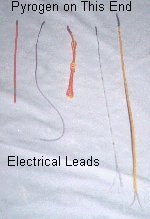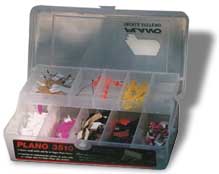Motors are electrically ignited, usually using a device called an electric match. A few brands of electric matches are shown below.

Electric matches have a pyrogren coating that is ignited when electricity passes through it. The burning pyrogen ignites the rocket motor.
Different igniter brands and models have different characteristics. Some require 12 volts, some less than 12 volts. Some can be used with electronic devices like timers and altimeters for igniting motors during flight, such as a multiple stage rocket, and ejection charges. Some igniters do not work well with clusters and electronic devices, usually because the battery used by the electronic device cannot supply sufficient voltage or current to a particular igniter.
Commercial Composite Motor Igniters
Characteristics of some common composite motor igniters are listed below in alphabetical order.
Copperhead
Copperhead igniters are sold by Aerotech, and provided with Aerotech motors. They are available in sizes to match all motors manufactured by Aerotech. They require 12 volts. These igniters are not recommended for clusters or electronically controlled air starts due to the amount of electricity needed to fire them. Folding or bending the igniters may render them unreliable.
Daveyfire
Very little electricity is needed to fire an Daveyfire igniter, and need to be handled and stored with care. They can be used alone with smaller (24mm - 29mm) motors. They are often enhanced with a pyrogen like Firestar pyrogen for larger motors. Because they need little electricity to fire they work well with timers and altimeters for staging, air starts and clusters.
Fire in the Hole
Manufactured by Trailing Edge Technologies, these igniters are available in multiple sizes to fit any motor, and with commonly used Nichrome bridge wires or special Tungsten bridge wires. The Tungsten bridge wire igniters are recommended for clusters, and electrically controlled air starts and staging. Both types provide quick and reliable ignition. (Note: At the time this review was written the pyrogen was brittle and needs to be handled and stored carefully to prevent it from breaking off the wire.)
Firestar
These electric matches are sold as a kit. The pyrogen chemicals are mixed by the user, and separately purchased wires are dipped into the pyrogen to create igniters. With 12 volts from a car, truck or similarly hefty battery these igniters provide consistent ignition. Due to the amount of electricity needed, they are not recommended for clusters or electronically controlled air starts. Wires are available to fit most E and larger (M+) motors. The pyrogen mix is sufficient to make
Lazerfire
Sold by Estes for its Darkstar motors, the igniters are also available in separate packs. The igniters need only 6 volts. They are available in a single length good for most E-G motors.
Note: Additional commercial igniters exist, but have not been used by the author and therefore no data is included at this time.
Submitted by: Dean A. Roth

Handy Igniter Storage Tip A handy way to store your ignitors and plugs is to use a little tackle box, sold at fishing supply stores–such as Bass Pro Shops. The Plano 3510, or similar, is perfect to keep those ignitor parts on hand and dry. Plano is a huge supplier of fishing tackle boxes and makes a great number of styles available, from full-blown tackle boxes to individual storage trays. A variety of storage configurations and sizes are available and are perfect for rocketry.
Submitted by: Doyle Tatum